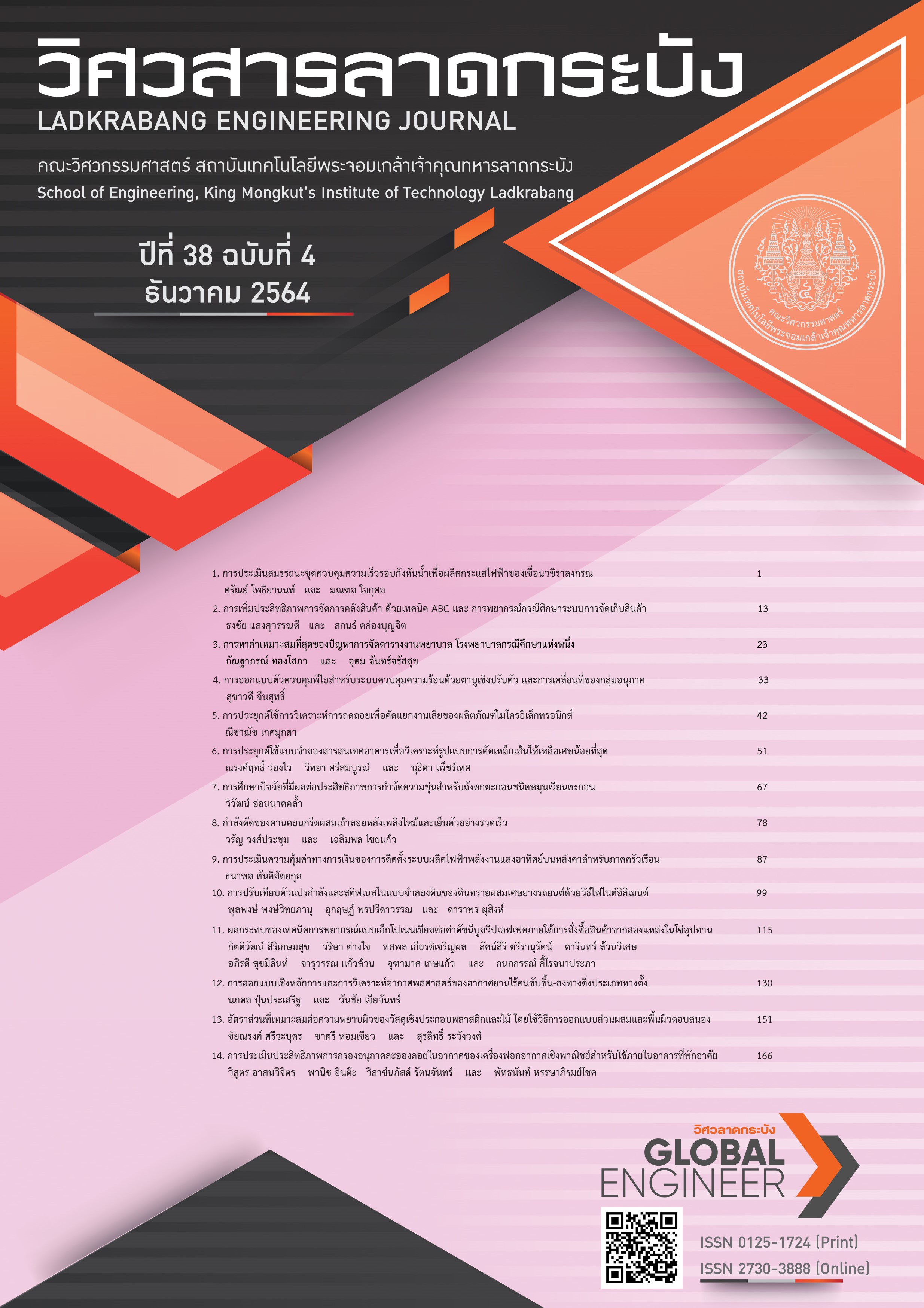Regression Analysis Applying for Defection Rescreening of Microelectronics Product
Keywords:
Regression analysis, Microelectronics, QualityAbstract
Consumer devices, such as laptops, personal data storage, and smart phones, are currently thin, compact, and light-weight. As a result, microelectronics is widely used in consumer electronics. Thailand is home to a number of manufacturers that provide microelectronics products to the market. There are two types of electronics manufacturer: provider solutions and owner brands. The print circuit board dimension 100×200×1 millimeters is now being used in the manufacturing case study. They discovered that the product failed at the test station (Functional Test), with the bulk of the root cause being a void in the through hole that exceeded the customer's requirements. A cross section and measurement are required to check the void in the through hole. This is a destructive measurement with a long lead time, and the factory does not want to rescreen any units by using a destructive method. The goal of this study is to use regression analysis to estimate void % using X-Ray image measurement as a predictor. The research found that the regression model may be used to re-screen defective printed circuit boards (the regression coefficient is not zero at 95 percent confidence intervals, and the adjusted R-square is 88.18 percent) without destroying the part. This is a practical and time-saving method. Furthermore, the factory and the supplier both acknowledge and agree on this regression model.
References
H. Iwai, K. Kakushima and H. Wong, “Challenges for future semiconductor manufacturing,” International Journal of High Speed Electronics and Systems, vol. 16, no. 1, pp. 43–81, 2006.
L. Errighi and C. Bodwell, “. Global trends in the E&E industry,” Electrical and electronics manufacturing in Thailand: Exploring challenges and good practices in the workplace, Bangkok, Thailand: International Labor Organization, 2017, ch. 2, pp. 2–4.
T. F. Edgar, S. W. Butler, W. J. Campbell et al., “Automatic control in microelectronics manufacturing: Practices, challenges, and possibilities,” Automatica, vol. 36, no. 11, pp. 1567–1603, 2000, doi: 10.1016/S0005-1098(00)00084-4.
X. Wu and W. Sha, “Experimental study of the voids in the electroless copper deposits and the direct measurement of the void fraction based on the scanning electron microscopy images,” Applied Surface Science, vol. 225, no. 7, pp. 4259–4266, 2009, doi: 10.1016/j.apsusc.2008.11.015.
R. Noyce, “Microelectronics,” Scientific American, vol. 237, no. 3, pp. 62–69, 1977.
H. Zhang, J. Minter and N. C. Lee, “A Brief Review on High-Temperature, Pb-Free Die-Attach Materials,” Journal of Electronic Materials, vol. 48, pp. 201–210, 2019, doi: 10.1007/s11664-018-6707-6.
H. George, “The Technical Introduction to the Third Edition,” in Wire Bonding in Microelectronics, 3rd ed. New York, NY, USA.: McGraw-Hill, 2010, ch. 1, sec. 1.1, pp. 2–3.
B. Razavi, “Introduction to microelectronics,” in Fundamental of microelectronics: with robotics and bioengineering application, 3rd ed., California, CA, USA.: John Wiley & Sons Inc., 2021, ch. 1, sec. 1.1, pp. 1–2.
Qualification and Performance Specification for High Frequency (Microwave) Printed Boards, IPC-6018, 2016.
X. Huang, S. Zhu, X. Huang et al., "Detection of plated through hole defects in printed circuit board with X-ray," presented at the 16th International Conference on Electronic Packaging Technology (ICEPT), Changsha, China, Aug. 11–14, 2015, doi: 10.1109/ICEPT.2015.7236817.
M. Pacheco and D. Goyal, "X-ray computed tomography for non-destructive failure analysis in microelectronics," presented at 2010 IEEE International Reliability Physics Symposium, Anaheim, CA, USA., Jun. 17, 2010, doi: 10.1109/IRPS.2010.5488820.
W. P. Dow and H. H. Chen, “A novel copper electroplating formula for laser-drilled micro via and through hole filling”, Circuit World, vol. 30, no. 3, pp. 33–36, 2004, doi: 10.1108/03056120410520597.
D. Montgomery, E. Peck and G.Vining, “Simple Linear Regression,” Introduction to Regression Analysis, New Jersey, NJ, USA.: John Wiley & Sons Inc., 2006, ch. 2, sec. 2.1, pp. 12–13.
W. D. Dupont and W. D. Plummer, “Power and Sample Size Calculations for Studies Involving Linear Regression,” Controlled Clinical Trials, Vol. 19, no. 6, pp. 589–601, 1998, doi: 10.1016/s0197-2456(98)00037-3.
S. W. Choi and D. H. D. Tran, “Calculating sample size Alpha, Beta, Mu and Sigma – it’s all Greek,” Journal of the Association of Anaesthetists, vol. 71, no. 4, pp. 462–264, 2016, doi: 10.1111/anae.13369.
T. Hong, M. Gui, M. E. Baran and H. L. Willis, "Modeling and forecasting hourly electric load by multiple linear regression with interactions," presented at IEEE PES General Meeting, Minnesota, MN, USA, Jul. 25–29, 2010, doi: 10.1109/PES.2010.5589959.
T. Abbasi, K. H. Lim, N. S. Rosli, I. Ismail and R. Ibrahim, "Development of Predictive Maintenance Interface Using Multiple Linear Regression," presented at International Conference on Intelligent and Advanced System (ICIAS), Kuala Lampur, Malaysia, Aug 13–14, 2018, doi: 10.1109/ICIAS.2018.8540602.
A. K. Kada, V. M. Wagh, A. A. Muley, B. N. Umrikar and R. N. Sankhua, “Prediction of water quality index using artificial neural network and multiple linear regression modelling approach in Shivganga River basin, India,” Modeling Earth Systems and Environment, vol. 5, pp. 951–962, 2019, doi: 10.1007/s40808-019-00581-3.
Garcíá, J. Sánchez, L. Rodríguez-Picón, L. Mendez and H. Ochoa, “Using regression models for predicting the product quality in a tubing extrusion process,” Journal of Intelligent Manufacturing, vol. 30, pp. 2535–2544, 2019, doi: 10.1007/s10845-018-1418-7.
Downloads
Published
How to Cite
Issue
Section
License
Copyright (c) 2021 Faculty of Engineering, King Mongkut’s Institute of Technology Ladkrabang

This work is licensed under a Creative Commons Attribution-NonCommercial-NoDerivatives 4.0 International License.
The published articles are copyrighted by the School of Engineering, King Mongkut's Institute of Technology Ladkrabang.
The statements contained in each article in this academic journal are the personal opinions of each author and are not related to King Mongkut's Institute of Technology Ladkrabang and other faculty members in the institute.
Responsibility for all elements of each article belongs to each author; If there are any mistakes, each author is solely responsible for his own articles.






